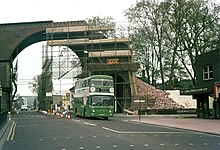
The Bluebell Railway is an 11 mi (17.7 km) heritage line almost entirely in West Sussex in England, except for Sheffield Park which is in East Sussex. It is managed by the Bluebell Railway Preservation Society. It uses steam trains which operate between Sheffield Park and East Grinstead, with intermediate stations at Horsted Keynes and Kingscote.

The London, Brighton and South Coast Railway was a railway company in the United Kingdom from 1846 to 1922. Its territory formed a rough triangle, with London at its apex, practically the whole coastline of Sussex as its base, and a large part of Surrey. It was bounded on its western side by the London and South Western Railway (L&SWR), which provided an alternative route to Portsmouth. On its eastern side the LB&SCR was bounded by the South Eastern Railway (SER)—later one component of the South Eastern and Chatham Railway (SE&CR)—which provided an alternative route to Bexhill, St Leonards-on-Sea, and Hastings. The LB&SCR had the most direct routes from London to the south coast seaside resorts of Brighton, Eastbourne, Worthing, Littlehampton and Bognor Regis, and to the ports of Newhaven and Shoreham-by-Sea. It served the inland towns and cities of Chichester, Horsham, East Grinstead and Lewes, and jointly served Croydon, Tunbridge Wells, Dorking and Guildford. At the London end was a complicated suburban and outer-suburban network of lines emanating from London Bridge and Victoria, and shared interests in two cross-London lines.

Coulsdon North is a closed railway station that served Coulsdon, Croydon, England, on the Brighton Main Line.

The East Coastway line is a railway line along the south coast of Sussex to the east of Brighton, England. Trains to the west of Brighton operate on the West Coastway line. Together with the West Coastway and the Marshlink line to the east, the line forms part of a continuous route from Havant to Ashford. The Brighton Main Line route to Eastbourne and Hastings, via Plumpton and Cooksbridge, shares the East Coastway line east of Lewes station.

The West Coastway line is a railway line in England linking the conurbations of Brighton/Hove/Littlehampton and Southampton/Portsmouth, with 1.3 million people between them. It has short southward branches to Littlehampton and Bognor Regis, which offer direct services to and from London.
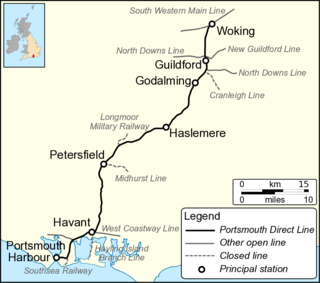
The Portsmouth Direct line is a railway route between Woking in Surrey and Portsmouth Harbour in Hampshire, England. It forms the principal route for passenger trains between London, Guildford and Portsmouth; connections are made to the ferry services which operate between Portsmouth and the Isle of Wight. The final section of line from Havant to Portsmouth is shared with other passenger routes.

Kemp Town railway station was the terminus station of the Kemp Town branch line, a short branch line serving the Kemptown district of Brighton, England.

The Hayling Island branch was a short railway branch line in Hampshire, England, that connected a station on Hayling Island with the main line network at Havant. It was built by the Hayling Railway; at first the company planned to run it along a new embankment built along tidal mudflats, but this proved impractical. The line was opened along firm ground in 1867.
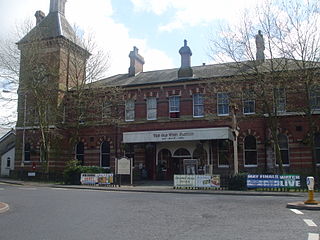
Tunbridge Wells West is a railway station located in Royal Tunbridge Wells, Kent. It is one of two railway stations in Tunbridge Wells constructed by rival companies. The other, Tunbridge Wells Central was opened in 1845 by the South Eastern Railway (SER). Tunbridge Wells West was closed to mainline passenger services in 1985, but part of it still remains as a heritage railway line. Opened in 1996, it stands next to the original engine shed. The line is called the Spa Valley Railway.
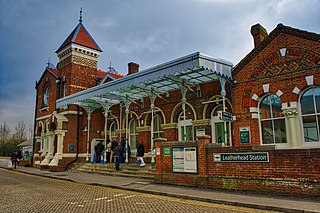
Leatherhead railway station is in Leatherhead, Surrey, England. It is managed by Southern, with services provided by them and South Western Railway. It is 18 miles 2 chains (29 km) from London Waterloo.
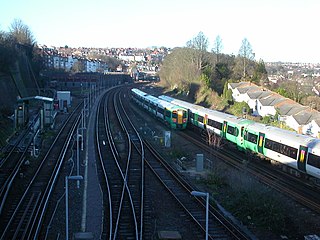
Public transport in Brighton and Hove, a city on the south coast of England, dates back to 1840. Brighton and Hove has a major railway station, an extensive bus service, many taxis, coach services, and it has previously had trolley buses, ferries, trams, auto rickshaws and hydrofoils.
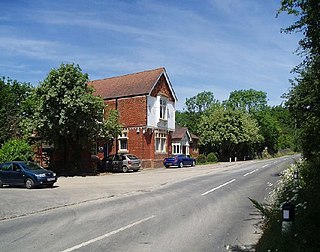
Ardingly was a railway station which served the West Sussex village of Ardingly in England. It was opened on 3 September 1883 by the London, Brighton and South Coast Railway (LBSCR) closed eighty years later and is currently used as an aggregates depot. The Bluebell Railway owns the trackbed from just east of the station to Horsted Keynes and has long-term plans to rebuild the line.
The Midhurst Railways were three branch lines which were built to serve the market town of Midhurst in the English county of West Sussex. The three lines were the Petersfield Railway, from Petersfield; the Mid-Sussex Railway extended by the Mid-Sussex and Midhurst Junction Railway, from Hardham Junction (Pulborough); and from Chichester. The Petersfield Railway opened in 1864, the promoting company having been absorbed by the London and South Western Railway (LSWR) in 1863. The Mid-Sussex lines reached Midhurst in 1866, after being absorbed by the London, Brighton and South Coast Railway (LBSCR) in 1862. The two lines did not connect, and there were two separate stations close by one another. The Chichester line took much longer to complete, and was opened in 1881, and a new LBSCR station was opened, replacing the first station. In 1925 the former LSWR line was connected to that station.
The Three Bridges–Tunbridge Wells line is a mostly disused railway line running from Three Bridges in West Sussex to Tunbridge Wells Central in Kent via East Grinstead in West Sussex, a distance of 20 miles 74 chains (33.7 km). Opened in 1855, the main section of the line was a casualty of the Beeching Axe – the last train ran on 1 January 1967. The remaining section to Tunbridge Wells closed on 6 July 1985, although the section between Groombridge and Tunbridge Wells West was reopened in 1997 under the auspices of the Spa Valley Railway.
The Wealden Line is a partly abandoned double track railway line in East Sussex and Kent that connected Lewes with Tunbridge Wells, a distance of 25.25 miles (40.64 km). The line takes its name from the Weald, the hilly landscape the lies between the North and South Downs.
Lewes Road railway station was a railway station in Brighton, East Sussex. It was located on the now closed Kemp Town branch line which first opened in 1869. The station opened on 1 September 1873 and was closed to passengers in 1933 but the line remained opened for goods trains until 1971.

Hartington Road Halt railway station was a stop on the Kemp Town branch railway line between Brighton station and Kemp Town, Brighton, East Sussex. It was open only briefly between 1906 and 1911. The line it stood on was closed permanently in 1971 and has now been demolished.

The Brighton and Dyke Railway was an independent railway company which built a branch line from Brighton in East Sussex to the Devil's Dyke, a popular beauty spot nearby in the South Downs, England. The line opened in 1887. The intermediary Golf Club Halt opened in 1891 and Rowan Halt opened in 1934. The line was not commercially successful and closed in 1939.

The Portsmouth line is a secondary main line originally built by the London, Brighton and South Coast Railway and the London and South Western Railway between 1847 and 1868. It leaves the South London Line at Peckham Rye, with connections to the Victoria branch of the Brighton Main Line at Streatham, and continues via Sutton, Epsom and Dorking to join the Mid-Sussex Line at Horsham.
The Portsmouth to Brighton Railway was built by the London, Brighton and South Coast Railway and its immediate predecessor in several stages.

